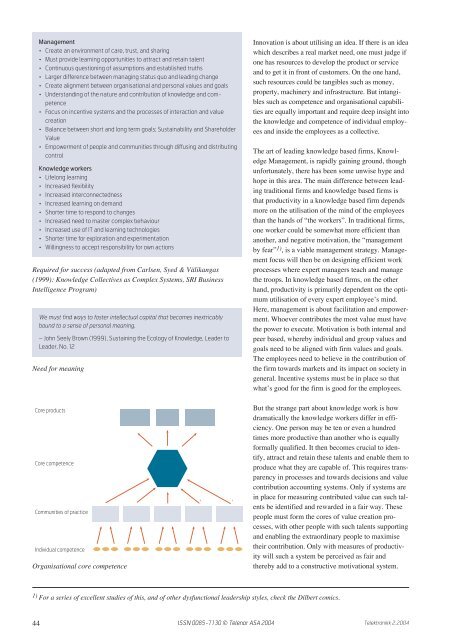Innovation Practice - Telenor
Innovation Practice - Telenor
Innovation Practice - Telenor
You also want an ePaper? Increase the reach of your titles
YUMPU automatically turns print PDFs into web optimized ePapers that Google loves.
44<br />
Management<br />
• Create an environment of care, trust, and sharing<br />
• Must provide learning opportunities to attract and retain talent<br />
• Continuous questioning of assumptions and established truths<br />
• Larger difference between managing status quo and leading change<br />
• Create alignment between organisational and personal values and goals<br />
• Understanding of the nature and contribution of knowledge and competence<br />
• Focus on incentive systems and the processes of interaction and value<br />
creation<br />
• Balance between short and long term goals; Sustainability and Shareholder<br />
Value<br />
• Empowerment of people and communities through diffusing and distributing<br />
control<br />
Knowledge workers<br />
• Lifelong learning<br />
• Increased flexibility<br />
• Increased interconnectedness<br />
• Increased learning on demand<br />
• Shorter time to respond to changes<br />
• Increased need to master complex behaviour<br />
• Increased use of IT and learning technologies<br />
• Shorter time for exploration and experimentation<br />
• Willingness to accept responsibility for own actions<br />
Required for success (adapted from Carlsen, Syed & Välikangas<br />
(1999): Knowledge Collectives as Complex Systems, SRI Business<br />
Intelligence Program)<br />
We must find ways to foster intellectual capital that becomes inextricably<br />
bound to a sense of personal meaning.<br />
– John Seely Brown (1999), Sustaining the Ecology of Knowledge, Leader to<br />
Leader, No. 12<br />
Need for meaning<br />
Core products<br />
Core competence<br />
Communities of practice<br />
Individual competence<br />
Organisational core competence<br />
<strong>Innovation</strong> is about utilising an idea. If there is an idea<br />
which describes a real market need, one must judge if<br />
one has resources to develop the product or service<br />
and to get it in front of customers. On the one hand,<br />
such resources could be tangibles such as money,<br />
property, machinery and infrastructure. But intangibles<br />
such as competence and organisational capabilities<br />
are equally important and require deep insight into<br />
the knowledge and competence of individual employees<br />
and inside the employees as a collective.<br />
The art of leading knowledge based firms, Knowledge<br />
Management, is rapidly gaining ground, though<br />
unfortunately, there has been some unwise hype and<br />
hope in this area. The main difference between leading<br />
traditional firms and knowledge based firms is<br />
that productivity in a knowledge based firm depends<br />
more on the utilisation of the mind of the employees<br />
than the hands of “the workers”. In traditional firms,<br />
one worker could be somewhat more efficient than<br />
another, and negative motivation, the “management<br />
by fear” 1) , is a viable management strategy. Management<br />
focus will then be on designing efficient work<br />
processes where expert managers teach and manage<br />
the troops. In knowledge based firms, on the other<br />
hand, productivity is primarily dependent on the optimum<br />
utilisation of every expert employee’s mind.<br />
Here, management is about facilitation and empowerment.<br />
Whoever contributes the most value must have<br />
the power to execute. Motivation is both internal and<br />
peer based, whereby individual and group values and<br />
goals need to be aligned with firm values and goals.<br />
The employees need to believe in the contribution of<br />
the firm towards markets and its impact on society in<br />
general. Incentive systems must be in place so that<br />
what’s good for the firm is good for the employees.<br />
But the strange part about knowledge work is how<br />
dramatically the knowledge workers differ in efficiency.<br />
One person may be ten or even a hundred<br />
times more productive than another who is equally<br />
formally qualified. It then becomes crucial to identify,<br />
attract and retain these talents and enable them to<br />
produce what they are capable of. This requires transparency<br />
in processes and towards decisions and value<br />
contribution accounting systems. Only if systems are<br />
in place for measuring contributed value can such talents<br />
be identified and rewarded in a fair way. These<br />
people must form the cores of value creation processes,<br />
with other people with such talents supporting<br />
and enabling the extraordinary people to maximise<br />
their contribution. Only with measures of productivity<br />
will such a system be perceived as fair and<br />
thereby add to a constructive motivational system.<br />
1) For a series of excellent studies of this, and of other dysfunctional leadership styles, check the Dilbert comics.<br />
ISSN 0085-7130 © <strong>Telenor</strong> ASA 2004<br />
Telektronikk 2.2004

















